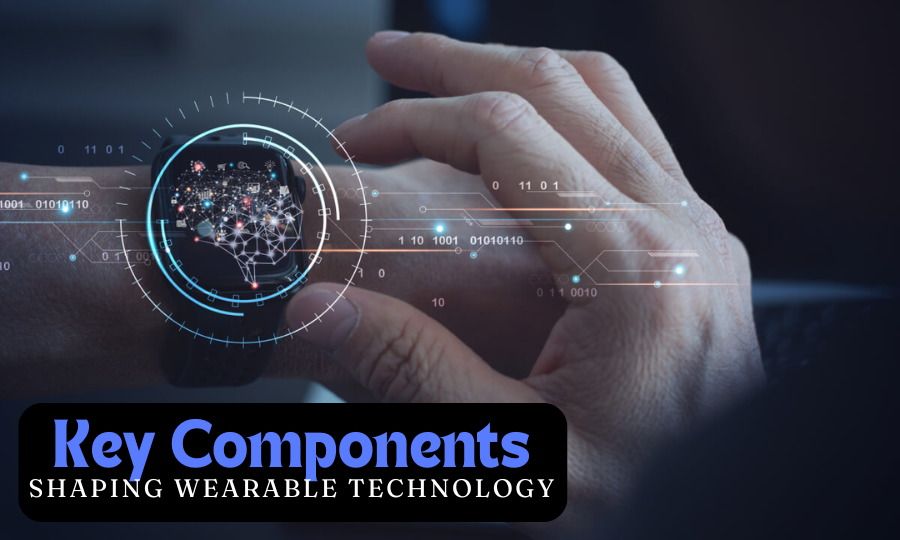Wearable technology is becoming a bigger part of everyday life. Smartwatches, fitness trackers, and smart glasses help people stay connected, track their health, and improve productivity. But what makes them work? Let’s take a look at the key components that power these smart devices.
1. Microcontrollers: The Brains of Wearables
Every wearable device has a microcontroller that controls how it works. It processes data, manages power, and connects to sensors. Whether it’s a smartwatch tracking steps or a smart ring monitoring sleep, the microcontroller makes sure everything runs smoothly.
Different devices require different microcontrollers. Some handle simple tasks, while others support advanced features like AI-powered health tracking. Some examples of microcontrollers used in wearable devices include the ARM Cortex-M series and the ESP32. These small chips help devices stay small, fast, and efficient.
2. Sensors: Collecting data In Real-Time
Wearable devices use sensors to collect information about movement, health, and the environment. These sensors work together to provide users with real-time data and help them make better choices about their health and daily activities. Some of the most common sensors include:
- Heart rate sensors – Measure heart rate using light-based technology.
- Accelerometers and gyroscopes – Detect movement and position, useful for counting steps and tracking workouts.
- Temperature sensors – Check body temperature in smart rings and health monitors.
- Electromyography (EMG) sensors – Monitor muscle activity for fitness or medical purposes.
3. Wireless Communication: Staying Connected
Wearable devices need to connect to other gadgets like smartphones, tablets, or the internet to stay connected. Wireless technology makes this possible. Strong wireless connectivity ensures that wearable devices can quickly send and receive data, whether they are syncing workout progress or getting notifications. The most common options include:
- Bluetooth Low Energy (BLE) – Syncs with phones while using less battery.
- Wi-Fi – Connects wearable devices to the internet without the need for a phone.
- Near Field Communication (NFC) – Enables fast, contactless payments.
4. Battery and Power Management
Wearable technology components should last a long time on a single charge. Most use lithium-ion (Li-ion) or lithium-polymer (Li-Po) batteries, which provide good battery life in a small size.
To save power, smartwatches and fitness trackers include power management features. When not in use, they switch to low-power mode and turn off unnecessary functions to extend battery life.
5. Display and User Interface
The screen on a wearable device needs to be clear, bright, and energy-efficient. Touchscreens, buttons, and voice control also help users simply interact with their wearable devices. Some common display types include:
- OLED and AMOLED screens – display sharp colors and save battery.
- E-ink displays – consume less power and are easy to read in sunlight.
- LED indicators – are used in simple devices like smart rings to show alerts.
6. AI and Data Processing
Modern wearables do more than just collect data. They use artificial intelligence (AI) to analyze the information and provide useful insights. AI helps devices predict health trends, analyze sleep, and suggest workouts.
Some wearables process data directly on the device, rather than sending it to a cloud server. This is called edge computing, and it provides faster responses while keeping data more private.
7. Materials and Design
Wearables need to be light, comfortable, and durable because people wear them all day long. The materials used play a big role in this. Good design makes wearables easier to wear and more appealing to users.
- Silicone and rubber – Used for straps and bands because they are soft and skin-friendly.
- Titanium and stainless steel – Make premium wearables strong and stylish.
- Flexible electronics – Let smart clothes and next-generation wearables bend and stretch.
8. Software and App Integration
A wearable is only as good as the software that runs it. Most wearables connect to mobile apps that store and analyze data. These apps help users track fitness goals, sleep patterns, and other activities.
Many smartwatches also support third-party apps, allowing users to install additional features such as music players, GPS navigation, or workout trackers.
9. Security and Privacy Features
Wearable devices collect personal data, so security is a major concern. Companies add features to protect user information. These security measures help users trust their wearable devices without worrying about data leaks. Some of these include:
- Encryption – Keeps data secure while being sent between devices.
- Biometric authentication – Uses fingerprint or face unlock for security.
- Privacy settings – Let users control what data is shared.
10. Role of Microcontrollers in Wearables
Microcontrollers play a big role in wearables. But how do microcontrollers work in these gadgets? They act as the central control unit, handling tasks like sensor readings, data processing, and communication.
For example, when a fitness tracker detects movement, the microcontroller processes the data, counts the number of steps, and sends it to the app. Without a microcontroller, wearable devices would not be able to function.
Conclusion
Wearable technology is powered by microcontrollers, sensors, wireless connections, power management, and AI. These key components allow devices to track health, send alerts, and help users stay connected.
As technology improves, wearable devices will become smarter, with better sensors, longer battery life, and more user-friendly designs. Whether it’s a smartwatch, fitness band, or smart glasses, the future of wearables looks exciting!
